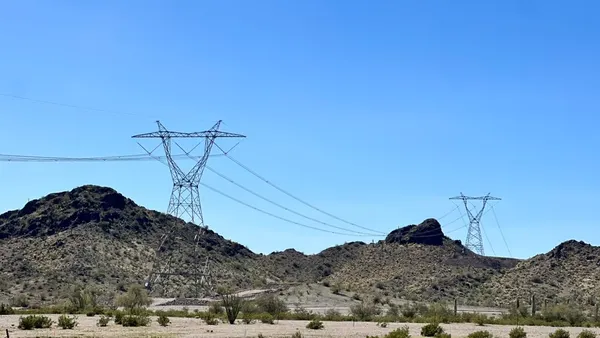With the end of 2022 fast approaching, many of us in the utility industry are considering grid lessons learned over the past year.
Extreme weather. Major wildfires. The accelerated adoption of electric vehicle and renewables in response to more aggressive decarbonization goals. Each serves to highlight grid challenges and opportunities for improvement.
Heatwaves and Hurricane Ian served up particularly clear and actionable lessons for utilities to lean into in 2023. Both illustrate the importance of resilience and responsiveness — grid resilience, and the responsiveness of utility customers, utility workers, and of utilities themselves.
Heatwaves
Longer than normal heatwaves with historically high temperatures stressed the grid in two of the country’s most populous states over the summer.
The July heatwave in Texas took the state’s grid dangerously close to maximum grid capacity, briefly exceeding the combined peak demand of California and New York at over 80,000 megawatts.

Shortly after, in early September, a long-lasting heat dome brought historically high temperatures to the West, fueling wildfires and stressing California’s power grid. Between energy emergency alerts, financial incentives to reduce power usage, and a state of emergency proclamation issued by the governor, California managed to narrowly avoid power shortages and black outs.
Grid Lesson #1
These power shortage near-misses in Texas and California show demand response programs to be effective, particularly in times of energy emergencies. But for the distribution grid to withstand increasingly common and intense heatwaves, growing electrification needs, and the transition to cleaner energy, utilities need to leverage multiple energy saving technologies and programs.
Relying upon customer responsiveness and engagement with usage reduction programs isn’t enough. Grid technology solutions that are not based on customer engagement and compliance offer much needed additional energy efficiency on a consistent, ongoing basis.
How Can Utilities Achieve More Energy Savings?
Utilities are evaluating the effectiveness of their energy efficiency initiatives and looking for additional savings beyond demand response programs and conservation voltage reduction (CVR) methods such as Volt VAR optimization (VVO).
CVR, Only Better
VVO programs address system voltage drops associated with inductive loads by using reactive resources, like capacitors, to flatten and boost voltage profiles. These CVR/VVO efforts are typically focused on the medium-voltage segments of the grid but broadening the scope of CVR/VVO to the low-voltage segments provides significant incremental savings as is illustrated below.
VOLTAGES ALONG DISTRIBUTION FEEDERS WITH AND WITHOUT CVR

CVR allows voltage to be reduced while maintaining a minimum level of 116V for all customers. Graphic from PowerEng.com
Low Voltage Dynamic VAR Control Delivers More Energy Savings
When applied to the low voltage side of the grid, dynamic VAR controllers (DVCs) effectively maximize energy savings by identifying low voltage outliers that are below a utility’s lower limit (e.g. 114-118V).
Sentient Energy’s dynamic VAR control system identifies low-voltage outliers and uses smaller capacitors to bring up these low points, creating more voltage margin. The increased voltage margin allows load tap changers (LTCs) and voltage regulators to be set at lower voltage levels — saving energy while still meeting minimum voltage requirements in all locations.
With a more precise approach to CVR/VVO, Sentient Energy’s Grid Edge Control™ solution can be installed exactly where it’s needed, enabling utilities to achieve valuable incremental energy savings.
Along with field-proven additional energy savings of 1-3% for utilities, utility customers benefit from increased voltage levels, improved power quality, and less fluctuations and flicker.
VOLTAGE PROFILES WITH GRID EDGE CONTROL

Voltage profiles are improved, and margins are created resulting in voltage reduction.
Field Trial of Low-Voltage DVCs — Results from ComEd
In a recent field trial ComEd augmented existing VVO with Sentient Energy’s Grid Edge Control solution. The trial involved 52 low voltage DVCs on four feeders from three substations with combined Annual MWh of 99,130.


By adding 52 dynamic VAR controllers for low voltage, ComEd boosted VVO savings by 58% on these feeders, increasing energy savings from 2.11% to 3.34%.

Energy savings were derived from a standard Sentient Energy calculation method, different than Illinois TRM. The incremental savings results from dynamic VAR controllers are feeder dependent and may not be feasible on every feeder.
An Important Additional Benefit — Increased Integration of PV Solar
Intermittent power and fluctuations associated with rooftop solar generation can increase wear and tear on equipment. As a result, utilities may choose to limit solar penetration on their distribution systems. By helping to mitigate fluctuations and reliably host more rooftop solar generation, low-voltage dynamic VAR controllers also contribute to increased grid capacity.
Hurricane Ian
With insured losses estimated at $67 billion, late September’s devastating Hurricane Ian knocked out power to more than 4 million customers in Florida and over 1.1 million in the Carolinas. Satellite images highlight the impact on the area of biggest impact, Florida’s Gulf Coast.

https://earthobservatory.nasa.gov/images/150431/power-outages-after-hurricane-ian
Grid Lesson #2
Executives at utilities impacted by Hurricane Ian credit grid hardening measures such as undergrounding of lines, grid modernization efforts, and cement poles for the ability to swiftly restore power.
And as Hurricane Ian recently illustrated, the human element of power grid restoration after a major weather event cannot be undervalued. Forbes explained in a recent article, “The mutual aid networks that can draw on the equipment and skills of distant electric utilities are what makes even the problematic U.S. grid as resilient as it is in the wake of big storms.”
However, grid resilience isn’t only a concern for hurricane prone states — it’s needed country wide. The NOAA map below shows 15 major weather/climate disaster events in 2022 (through October 11th) with losses exceeding $1 billion each.

Increasingly intense and frequent extreme weather events necessitate a continued focus on initiatives that increase grid resilience. One of the most effective approaches to grid resilience is undergrounding — both new undergrounding projects and the strategic undergrounding of existing at-risk distribution lines.
Many of the country’s largest utilities like FPL, PG&E, Dominion Energy and WEC Energy Group have initiated the undergrounding of at-risk overhead lines. Likewise, many municipalities, electric cooperatives, and publicly owned utilities have developed strategic undergrounding programs, while more are studying the pros and cons of burying at-risk overhead lines.
How can Utilities Augment Underground Reliability?
Overhead and underground intelligent line sensors provide visibility of key points along distribution feeders, allowing utilities to gain further reliability and resilience from undergrounded distribution systems. When deployed at transition points, overhead line sensors help utilities quickly know whether faults are overhead or underground.
To provide visibility of underground distribution feeders, line sensors like Sentient Energy’s UM3+™ can be installed in switch cabinets or vaults. Downstream of the feeder switches, into single phase underground residential distribution (URD), line sensors like the Sentient Energy UM1™ can be installed in transformer cabinets. Both sensors wirelessly report faults, precise location data, load data, and disturbances to a central sensor management software application.
Applying Yesterday’s Lessons to Tomorrow’s Tests
As severe weather events like prolonged heatwaves and hurricanes are projected to continue, so too will the necessity for energy savings through low voltage dynamic VAR control and grid hardening efforts that effectively boost the resilience of the power distribution system.
- Preparing for next year’s inevitable heat waves will require more than simply relying on customer engagement with usage reduction programs. Utilities need to leverage multiple energy saving technologies and programs such as dynamic Volt VAR optimization (VVO) to find additional energy savings beyond demand response programs and traditional conservation voltage reduction (CVR) methods.
- Preparing for next year’s extreme storms will require new approaches to improve grid resilience. Undergrounding is one of the most effective options for protecting at risk lines. Intelligent line sensing has emerged as a proven way to achieve further reliability and resilience, helping utilities quickly pinpoint whether faults are overhead or underground and speeding the time it takes to find and fix them.
Sentient Energy’s visibility, analytics, and control solutions help utilities tackle their most pressing grid challenges and make their energy savings, grid resilience, and modernization efforts more effective.










